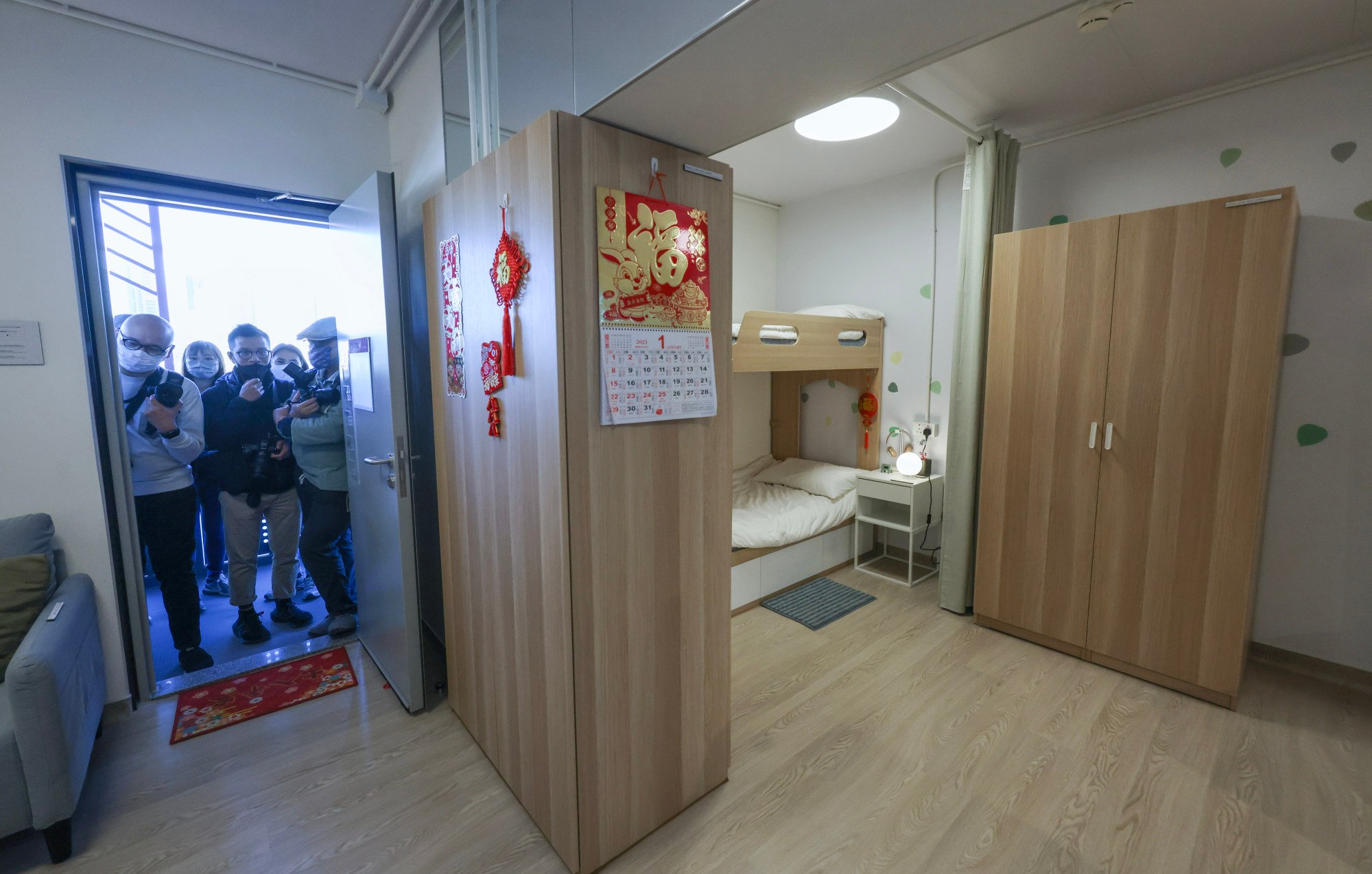
Hong Kong’s tiny subdivided flats a big problem that needs urgent attention, but can city leader John Lee’s policy address come up with solutions?
- Bill Tang, chairman of Legco’s welfare panel, says government should offer more social services support to people in subdivided flats as they wait for proper housing
- Legco housing panel member Vincent Cheng appeals to government for five-year plan to eliminate shoebox homes altogether
Hong Kong woman Mimi Zhou* was faced with a huge problem when her three sons aged 11 to 15 left mainland China in July and came to live with her in a tiny 70 sq ft flat.
The small space in Tsuen Wan was crammed with the family’s belongings and could only fit a bunk bed, used by the two older brothers.
The 35-year-old mother and her youngest son had to sleep on yoga mats laid out on the narrow space between the bed and the cooking area.
“One slight move could wake them up when I was preparing food,” Zhou said.

Statistics published this year showed the city was home to about 108,200 subdivided flats in 2021 with an average size of 118 sq ft and rent per month of HK$5,000 (US$639), which swallowed up a third of the monthly income of tenants.
About 7,800 transitional homes, a government plan to help families waiting for public rental flats and those living in tiny subdivided spaces, have been built so far and another 13,200 are expected to be available by 2024.
None of the 30,000 “light public housing” flats, another kind of stopgap government transitional home, have been completed.
Government advisers and housing experts called on the city’s leader to use Wednesday’s policy address to regulate the design of subdivided flats and strengthen tenants’ protection from unreasonable rental contracts as a temporary measure before decent housing became available.
Government sources said earlier that housing improvements would be a highlight in the policy blueprint for the next year.
Chief Executive John Lee Ka-chiu also revealed last month that the government was looking at potential solutions to the problem of subdivided flats, which are notorious for health, fire and security risks.
Bill Tang Ka-piu, chairman of the Legislative Council’s welfare panel, said the government should identify families in low-grade subdivided flats and support them with more social services before the temporary housing was ready.
“Different departments, including schools, should form a database together to get hold of their situation, including whether they have received government subsidies and are aware of the transitional flats. If not, the government can provide assistance,” he added.
Authorities could also define substandard housing by setting a minimum average living space per occupant and on other criteria such as having a combined kitchen and toilet, he proposed.
Vincent Cheng Wing-shun, a member of Legco’s housing panel, suggested a policy address target of elimination of low-quality shoebox homes within five years.
He said the government could tackle substandard housing using structural and fire safety laws, followed by stepped-up inspections and removal orders.
Cheng added affected tenants could be rehoused in temporary homes or public rental flats.
“I am worried that these substandard units will be leased to households one after another, no matter how much permanent and temporary housing we build,” he explained.
Cheng added authorities should also step up enforcement to ensure tenants were protected from unreasonable rent increases and overcharged utility bills.
Subdivided flat owners are required to submit rent details to the government when starting a new lease or face a fine of HK$10,000 under the Landlord and Tenant (Consolidation) (Amendment) Ordinance, which came into force at the start of last year.
But the government had only received about 13,400 forms, around 10 per cent of the flats included in the legislation, by March.
Authorities also received 1,524 complaints connected to the landlord legislation by the same month, but there were only seven convictions by August, with the highest penalty a fine of HK$18,700.
Anthony Chiu Kwok-wai, executive director of the Federation of Public Housing Estates, urged the government to extend a pilot cash allowance scheme, designed for low-income households in the queue for a public flat for at least three years.
The government said it had identified enough land to provide about 360,000 public homes by 2032-33, one-third of which would be available over the next five years.
The average waiting time for a public flat is 5.3 years.
Chiu said in the interim, the government could extend the maximum mortgage guarantee period for subsidised homes from 30 to 40 years, as it would help vacate more public flats and help people on low incomes to move up the property ladder.
“It could increase the housing supply and assist more homebuyers,” he said.
The city has around 352,000 subsidised flats, with around 90 per cent of them at least 20 years old. About 40 per cent are 30 years old.
Zhou’s family managed to move to a larger flat nearby last month with the help of social workers.
The move doubled their living space and they now have a separate kitchen and some donated domestic appliances.
Zhou pays HK$6,000 a month in rent, 53 per cent more than she did before, but she said it was well worth it.
She added she still hoped for a permanent home after a three-year wait for a public flat.
“My son said he had to walk like a crab in the old home and stay cautious to avoid bumping into things … after his first night at the new place, he said he had a very good sleep,” Zhou said.
“Of course, it will be best if we can move into a public home as soon as possible.”
*Name changed at interviewee’s request

